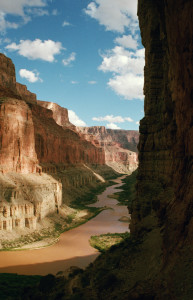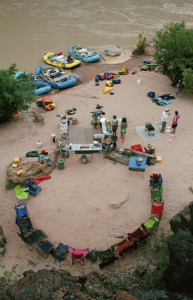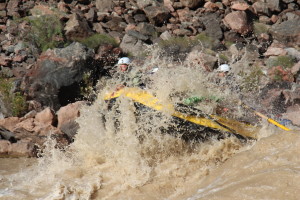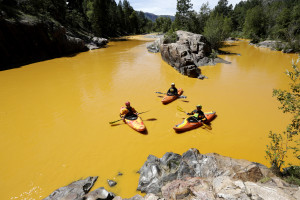(Photo’s 1 and 2 compliments of L. Harris and 3 from S. Langston, that’s me underwater)
What do you get when 16 people spend 23 days floating on crafts that carry all they need down the Grand Canyon? You get an experiment in community. One does not embark on such an adventure without to be awed, changed or altered in some way. On the inside. A significant offering the Canyon provides, that words diminish when one tries to explain, is how the Canyon itself and the experience of community peel back layers of yourself, exposing your soul, leaving you feeling vulnerable and small and yet somehow part of something larger than yourself. Someone who has been given something special and must share it, through being. You don’t want to miss that part of the experience or resist receiving that gift, but you will try, it is human.
Let me explain. The Grand Canyon as a geologic and hydrologic wonder full of beauty, history, paradoxes, adventure, excitement, calm and risk. You are in wilderness for 280 river miles and decisions you make or don’t make can and do take lives. The only people you may see are folks on the same journey (and sometimes that is no one). No cell phone access only satellite phone in some places for emergency contact. Evacuations are by helicopter, expensive and for life threatening emergencies. It is the kind of experience you spend six or months planning, preparing and building expectations. You have a map, ample food, water, first aid, safety and back up gear and clothing – and each other. That’s it.
The Canyon is the classroom in which you and trip mates are the experiment. Decisions each of you make impact the entire group and overall experience. You put on the river as a group and must stay together through thick and thin until you take out because it is illegal to separate. After ten trips, I believe 9 out of 10 trips would separate if it was legal. Why? The challenges that comes with being in the unknown, in community and in yourself all at the same time. You don’t know what wonder is around the next bend and how to prepare, you have to trust. You experience doubt, fatigue, anxiety, fear, adrenaline and a sense of lack of control. And then you have to deal with the extrovert or introvert (whatever you aren’t), your dinner duty and/or the group member you just don’t get. You may even realize you don’t like someone, even hate them and wish they would get evacuated. You experiences many emotions and intensely at times.
The Canyon demands your attention and thus you spend long periods of time present, in the moment, which we can easily avoid in everyday life. The group as a whole has to react and respond to, manage and confront the next thing. While that may be a waterfall, a successful rapid run, a sweet hike, it also might be a flip (a boat full of gear turns upside down), an unintended swimmer, damaged equipment, an injury, illness, or a decision to make like where to camp or hike or eat lunch, or what to do about a group member(s) that disrupts the community dynamic beyond an acceptable level.
You can’t walk away literally or metaphorically (workaholic, check out with a device, keep moving so you never hear your inner voice, etc.). You can show up and deal or resist and ignore. Both are choices, both have consequences for you and the group. At the end you will be saying “I never thought I would….” You will hear yourself tell stories about the amazing Canyon but also about all the people on board. Sayings, phrases or songs you invented. Events that happened and what folks did or didn’t do in response. The experience of it all opens you up. You will change, but not like you thought. In your reflection you can list all the things that “were not provided in the brochure”.
This Grand Canyon community experience is just like everyday life. Distilling my life down to my own expectations, a dry bag, 16 people, five boats and 280 miles of wilderness is just the context for the day. I have distilled my everyday life in the same way. Expectations based on my beliefs and stories of how I should be and feel and how others should act and feel. My routines, habits, to-do-lists merge with my many communities. I need to be present but I often get sucked into stories of the past, worries about the future and create drama by focusing on others instead of myself. I don’t really know what is around the next bend but I create the illusion I am in control and directing my life, which erodes my trust muscles. I want the “difficult” person, entity, agency, authority, situation to just evaporate so I will be okay. But it doesn’t. And I am still okay.
There are many elements that make a group dynamic in community high vibrating. The obvious element is to have a common goal, in this case we all wanted a fabulous but safe adventure. This past trip was amazing and there were challenges on the river and in the group. We were high vibrating though and I believe that is because of three key ingredients. Ingredients I want to remember and bring to the remaining float down the river of my life, which I hope entails many years.
The three ingredients were:
1) Verbalized, agreed upon community norms. A group has norms, whether acknowledged or not. We selected key items we all agreed upon at the beginning that we would do to keep group safety and harmonious. This included acknowledging and valuing our differences as well as that we will feel something we don’t want to at times (scared, anxiety, anger, etc.) and that is okay. We delegated group tasks so everyone had a role and a communication structure to share issues, concerns and to make group decisions. We made these group norms the nucleus of our safety talk. As it played out, we each had to make a personal sacrifice at various times for the sake of holding these group norms. That is what it means to agree to a collective.
2) Self-rescue, meant more than it usually does on river trips. It usually means take care of your physical needs first if you can, don’t expect help and be resourceful. We expanded that meaning to include taking care of your emotional and mental health as well, but within boundaries. Hold yourself accountable, figure out what you are feeling and need and ask for it.
3) Holding the group accountable. Once our group’s dysfunction or dis-ease was out in the open. It was easy to make it about individuals. You know that point in a community, it is who the gossip is about, who is getting blamed, etc. And we did make it about a person, for a period. If we continued down that path we would have had to confront more serious issues. This is not to say, that individual did not have some accountability, they did, but they are one person in 16 to hold up group accountability. Blame never produces a solution, it only solidifies status quo like super glue. Conflict seems like it is about a person and a circumstance, but it never really is. It is always about something underneath the story.
We were brave enough, as a group (not some of us but all of us), to gather and put the elephants in center circle. Step one. That never usually resolves the issues. Putting elephants in front of the group gives each individual permission to own their role and part in transforming what has been illuminated for them and bring that learning back to the whole. It is being self-centered and focused for the wealth of the tribe, not for self-gain. It takes leadership to create step one. Step two, then is the group has to hold the individuals in the group accountable to the norms. Once the elephant is out, it requires the group to keep it in the herd. If the group falls back on one person (leader or not) to enforce group agreements then the group is not owning itself yet and will continue to create drama until it does.
New friendships were made on this past trip and a few friendships are forever altered, maybe terminated. Again, such as life. We create relationships to have experiences we need, they need, and when they are done, we have the opportunity to release them gracefully or in drama. What does gracefully mean? Acknowledge we are at different places in our growth, and that is neither good or bad, right or wrong, just is. I bless you on your path with your guides and I bless myself, we both count, even if I don’t get you and you don’t get me. Thank you for what you have given me and I wish you love and grace along your path.
We don’t have experiences to get over them. We have them to be seen, to be heard, to feel something we need, to grow and evolve or to resist change and maintain status quo. We create, invite, select, demand, and even attempt to control experiences. Experiences are part of being in this body this life time. We are never alone either, we always have ourselves, our guides, and our version of Source. Thus, even experiences in solitude are in community. We may feel alone, but that doesn’t mean we are. We are not our feelings. We create community all the time at home. Informally and formally. A family, a soccer team, the neighborhood, a project, a club, a hobby, work teams, a group of workshop attendees as examples. Life is one big community comprised of infinite smaller communities.
One gift the amazing, speechless Grand Canyon gifted me this trip, was that of conscious, intentional community. I am keenly aware of my role, value and contribution, or lack of in all my communities. I imagine this way of living in community could create amazing shifts in our world. Since the trip, I have given myself permission to leave some communities, strengthen others and forge new ones, all with a sense of wonder, awe, trust and conscious intent. These last few months, lunar and solar eclipses and the new moon in Scorpio, keep calling us to create and bring our unique gift to others, to collaborate and partner with others and to transform our inner stories and beliefs that keep us small and from valuing yourself in community. What is your response?




